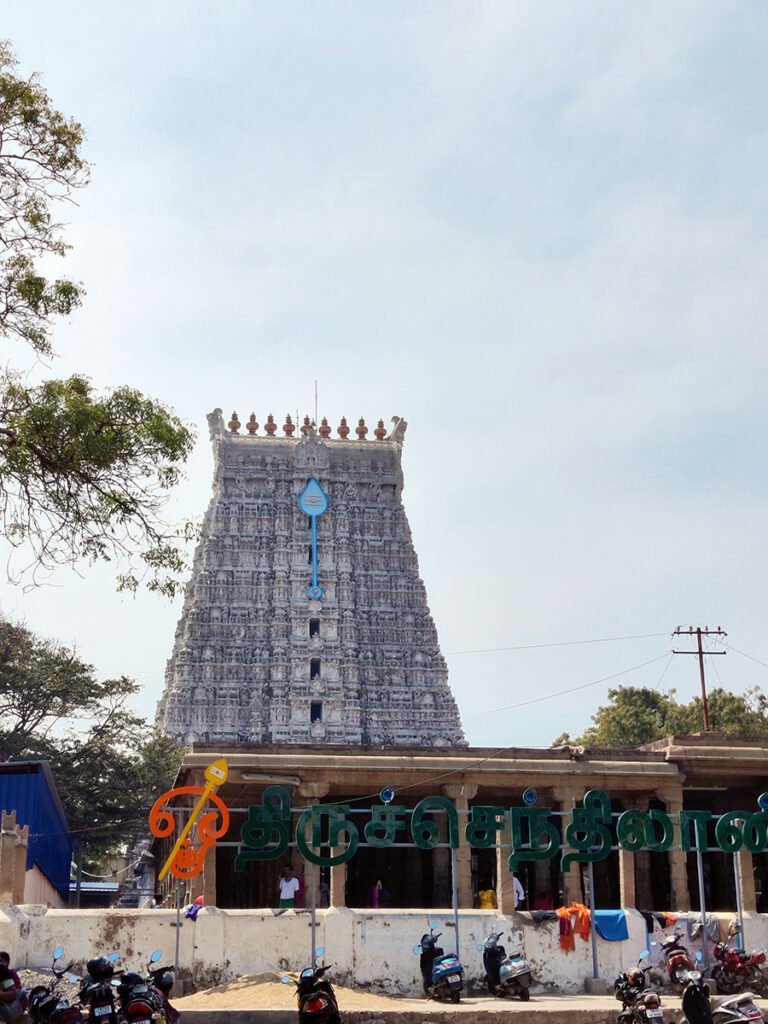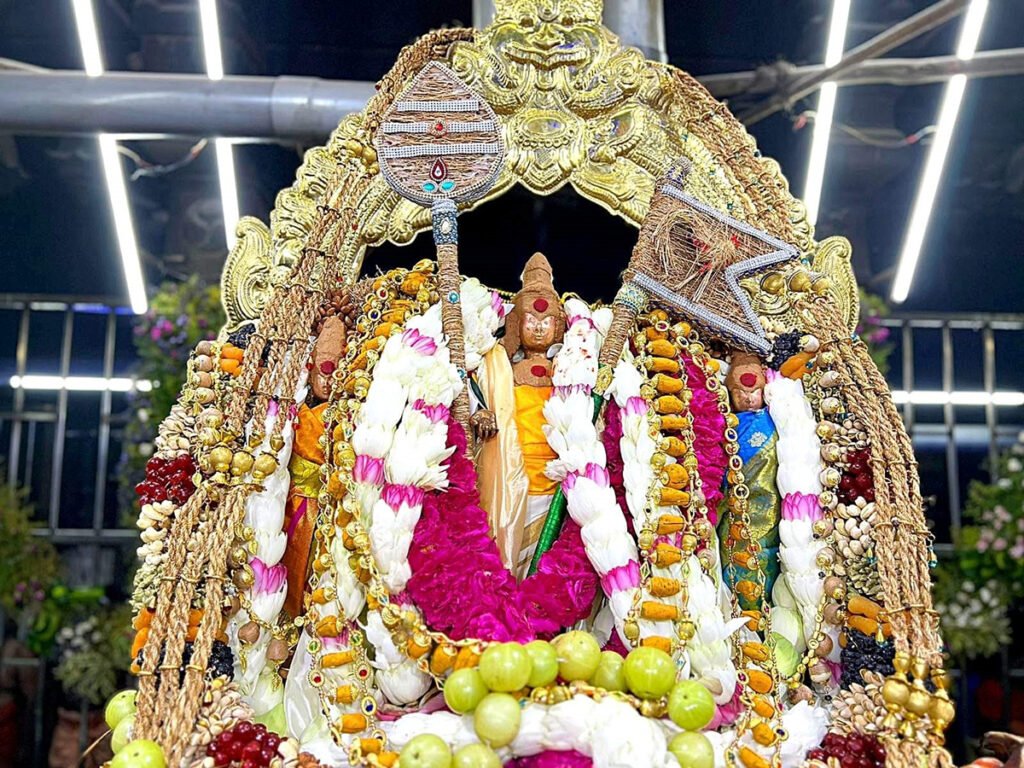Subramanya Swamy Temple at Thiruchendur A Sacred Gem
Subramanya Swamy Temple at Thiruchendur is a renowned Hindu temple located in Thiruchendur, a coastal town in the Thoothukudi district of Tamil Nadu, India. It is dedicated to Lord Subramanya, also known as Kartikeya or Murugan (the Hindu god of war, victory, and youth).

The Thiruchendur Murugan Temple is considered one of the six major abodes of Lord Murugan, known as Arupadaiveedu. It holds significant religious importance and attracts a large number of devotees throughout the year. The temple is situated on the shores of the Bay of Bengal, adding to its natural beauty and serene ambiance.
Contents
Architecture of Subramanya Swamy Temple at Thiruchendur:
The temple is believed to have been built in the 7th century CE by the Pallava king Narasimhavarman II. The present structure of the temple dates back to the 12th century CE, and was built by the Chola king Kulothunga Chola I.
The temple is a large complex and is surrounded by three concentric walls. The outer wall is 91 meters (299 feet) long and 65 meters (213 feet) wide. The inner wall is 72 meters (236 feet) long and 48 meters (157 feet) wide. The temple has a nine-tiered gopuram or tower gate, that is 157 feet (48 meters) high.
The inner sanctum of the temple houses the image of Murugan as a child, seated on a peacock. The image is made of granite, and is 6 feet (1.8 meters) tall.
The temple is a popular pilgrimage destination and is especially crowded during the annual Skanda Shasti festival, which is celebrated in the month of November.
Read More>> Miraculous Powers of Shri Khade Ganesh Temple Kota Kashivpur
Who built Subramaniya Swamy Temple at Tiruchendur?
The exact date of construction of the Subramaniya Swamy Temple Tiruchendur is unknown, but it is believed to have been built in the 7th century CE by the Pallava king Narasimhavarman II. The present structure of the temple dates back to the 12th century CE, and was built by the Chola king Kulothunga Chola I.
However, there is a legend that the temple was built by a saint named Mouna Swami. Mouna Swami was a great devotee of Murugan, and he prayed to god to build a temple in his honor. Murugan appeared to Mouna Swami in a dream and told him to build the temple on the coast of Thiruchendur. Mouna Swami then set to work, and he built the temple over a period of 72 years.
The temple is a beautiful and impressive structure and is a testament to the architectural skills of the Pallava and Chola periods. It is a popular pilgrimage destination and is especially crowded during the annual Skanda Shasti festival, which is celebrated in the month of November.
Read More>> Trikut Ganesh Temple Nanded

Specialities of the Thiruchendur Murugan Temple:
Skanda Sashti Festival: The temple is famous for its grand celebration of the Skanda Sashti festival, which commemorates the victory of Lord Murugan over the demon Surapadman. The festival lasts for six days and attracts a large number of devotees from far and wide.
Seashore Location: The temple is situated on the shores of the Bay of Bengal, providing a beautiful and serene backdrop. The combination of the temple’s architectural splendor and the scenic coastal environment makes it a popular pilgrimage destination.
Ancient Architecture: The temple boasts an impressive Dravidian architectural style. The main shrine features intricate carvings and sculptures, depicting various episodes from Hindu mythology. The gopurams (towers) and mandapams (halls) within the temple complex showcase the skill and artistry of the craftsmen of the bygone era.
Navagraha Shrine: Thiruchendur Murugan Temple is one of the few temples where the nine celestial deities or Navagrahas are worshiped in a separate shrine. Devotees believe that worshiping the Navagrahas at this temple can mitigate the negative effects of planetary positions and bring blessings.
Soorasamharam: One of the significant events that take place at the temple is the reenactment of Lord Murugan’s victory over the demon Surapadman. The dramatic and elaborate Soorasamharam (demon slaying) event during the Skanda Sashti festival attracts a large audience.
Submerged Shrine: Within the temple complex, there is a submerged shrine known as Valli’s Cave. Devotees can access this shrine by wading through knee-deep seawater. It is believed to be the place where Valli, one of Lord Murugan’s consorts, meditated.
Protective Sea Wall: The temple has a protective sea wall, known as the “Aandan Koil Valai,” which was built centuries ago to safeguard the temple from erosion caused by sea waves.
Read More>> Swaminatha Swamy Temple Swamimalai

Thiruchendur Murugan Temple Timing:
Morning:
The temple usually opens early in the morning.
Darshan Timing: 5:00 AM to 12:30 PM
Afternoon:
After the noon puja and rituals, the temple closes for a few hours.
Darshan Timing: 12:30 PM to 4:00 PM (approximately)
Evening:
The temple reopens in the evening for darshan.
Darshan Timing: 4:00 PM to 9:00 PM
Please note that these timings are approximate, and it’s advisable to check the temple’s official website or contact the temple authorities to get the most up-to-date and accurate information about the temple timings.
Places to visit near Thiruchendur Murugan Temple
Valliyur: Located about 13 kilometers from Tiruchendur, Valliyur is known for its scenic beauty and the Valliyur Kottamudayam Sastha Temple, dedicated to Lord Ayyappa.
Kayamozhi: Situated around 17 kilometers from Tiruchendur, Kayamozhi is famous for the Kayamozhi Sree Katyayani Bhagavathy Amman Temple, which attracts devotees with its unique idol of the goddess.
Manapad: Manapad is a coastal village located about 30 kilometers from Tiruchendur. It is known for the Holy Cross Church, where a miraculous floating cross is believed to have appeared in the sea.
Panchalankurichi: Situated approximately 38 kilometers from Tiruchendur, Panchalankurichi is a historically significant place associated with the warrior chieftain Veerapandiya Kattabomman. It houses a memorial fort dedicated to him.
Tuticorin (Thoothukudi): Tuticorin is a major port city located around 40 kilometers from Tiruchendur. It offers attractions like the Thoothukudi Harbor, Our Lady of Snows Basilica, and Roche Park Beach.
Kanyakumari: Located around 90 kilometers from Tiruchendur, Kanyakumari is a popular tourist destination known for its stunning sunrise and sunset views, Vivekananda Rock Memorial, Thiruvalluvar Statue, and the convergence of the Arabian Sea, the Bay of Bengal, and the Indian Ocean.

FAQ:
Q: Where is Subramanya Swamy Temple at Thiruchendur located?
A: Subramanya Swamy Temple at Thiruchendur is located in the Thiruchendur town of Thoothukudi district in Tamil Nadu, India. It is situated on the coast of the Bay of Bengal, about 70 kilometers from the city of Madurai.
Q: What is the significance of Subramanya Swamy Temple at Thiruchendur?
A: Subramanya Swamy Temple at Thiruchendur is one of the six abodes of Lord Murugan, the son of Lord Shiva and Parvati. It is believed that Lord Murugan defeated the demon Soorapadman at Thiruchendur, and the temple is a popular pilgrimage site for Hindus who come to worship Lord Murugan and seek his blessings.
Q: What are the best times to visit Subramanya Swamy Temple at Thiruchendur?
A: The best time to visit Subramanya Swamy Temple at Thiruchendur is during the summer months (April to June) when the weather is pleasant and the crowds are smaller. The temple is also open during the winter months (October to March), but the weather can be quite cold and the crowds can be larger.
Q: What are the things to do at Subramanya Swamy Temple at Thiruchendur?
A: The main activity at Subramanya Swamy Temple at Thiruchendur is to worship Lord Murugan. Visitors can also visit the temple complex, which includes a number of other shrines and temples dedicated to Lord Murugan and other Hindu deities. The temple also has a number of other attractions, including a beach, a museum, and a market.
Q: What are the safety tips for visiting Subramanya Swamy Temple at Thiruchendur?
A: Here are some safety tips for visiting Subramanya Swamy Temple at Thiruchendur:
- Be respectful of the Hindu religion. The temple is a sacred Hindu temple, so it is important to be respectful of the religion and the customs.
- Be aware of the crowds. The temple can be very crowded, especially during festivals.
- Be careful of the monkeys. There are many monkeys in the area around the temple. It is important to be careful of the monkeys, as they can be aggressive and steal food from visitors.
- Be prepared for the heat. The weather can be very hot and humid in Thiruchendur, so it is important to be prepared for the heat.
Q: What are the other temples near Subramanya Swamy Temple at Thiruchendur?
A: There are a number of other temples near Subramanya Swamy Temple at Thiruchendur, including:
- Arulmigu Thiruchendur Mutharamman Temple: This temple is dedicated to the goddess Mutharamman, who is the consort of Lord Murugan.
- Arulmigu Thiruchendur Vinayaka Temple: This temple is dedicated to Lord Ganesha, who is the son of Lord Shiva and Parvati.
- Arulmigu Thiruchendur Nagarathar Temple: This temple is dedicated to Lord Vishnu, who is one of the three main deities of Hinduism.

How to reach the Temple:
By Air:
The nearest airport to Thiruchendur is Tuticorin Airport, also known as Thoothukudi Airport. It is located approximately 40 kilometers away from the temple. From the airport, you can hire a taxi or take a bus to reach Thiruchendur.
By Train:
Thiruchendur has its own railway station called Tiruchendur Railway Station, which is well-connected to major cities and towns in Tamil Nadu. From the railway station, you can hire a taxi, auto-rickshaw, or take a local bus to reach the temple.
By Road:
Thiruchendur is well-connected by road. You can reach the town by private vehicle or take a bus from nearby cities like Tirunelveli or Madurai. There are regular bus services available to Thiruchendur from major towns and cities in Tamil Nadu.
Local Transport:
Once you reach Thiruchendur, the temple is easily accessible within the town. You can hire a local auto-rickshaw or take a short walk to reach the temple complex.
It’s important to note that the temple is located near the coast, and the surrounding area is known for its scenic beauty. It’s advisable to plan your visit in advance, check the temple timings, and be aware of any specific rituals or festivals taking place during your visit.
